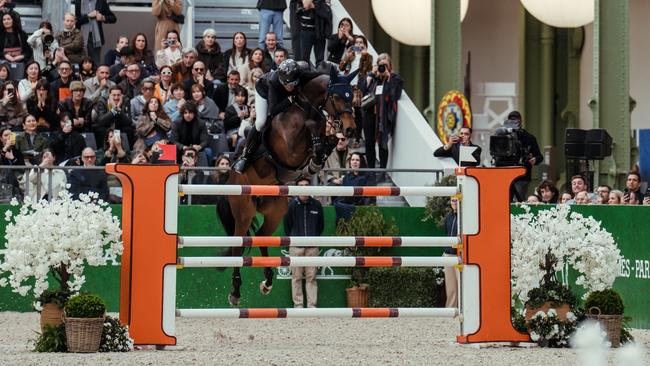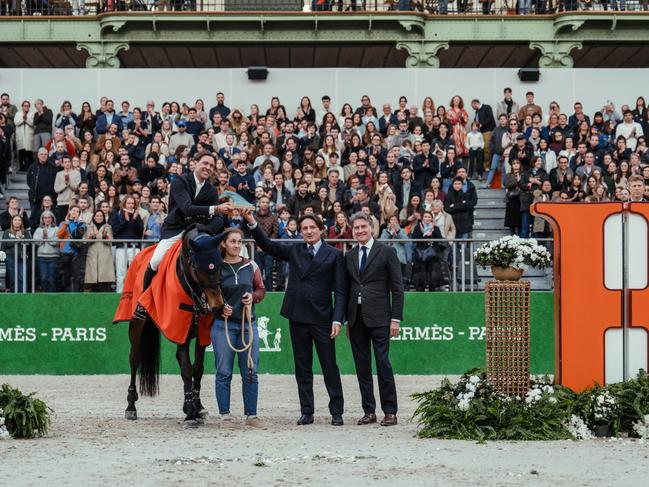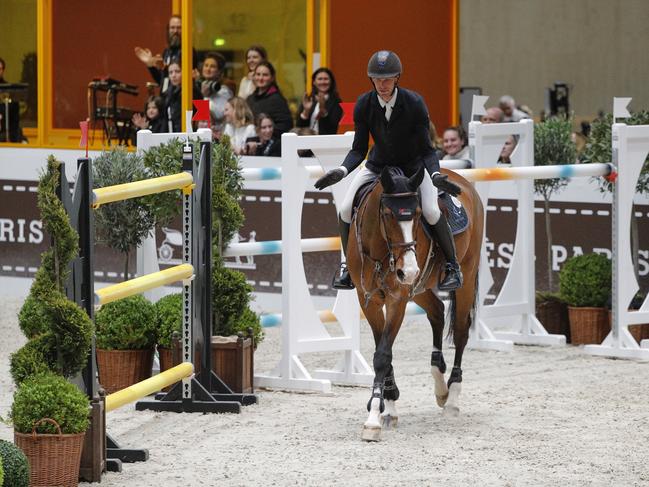And the horse wore Hermes
At its annual equestrian event in Paris, the French brand keeps in touch with its saddle-making roots

The former chairman of Hermès, Jean-Louis Dumas, used to say “the horse is the first client”. Horses were the French luxury brand’s first market in 1837, when it opened as a harness maker.
They are also its original muse, influencing stirrup-inspired closures on bags, designs on silk scarfs and in the company’s horse-and-carriage logo. Last week, that connection was on vivid display under the Grand Palais’s glass ceiling, where some of the top showjumpers in the world competed for branded rosettes and a €400,000 ($692,500) grand prize.
The Saut Hermès is among the most challenging equestrian competitions in the world, with hurdles reaching 1.60m. (“Saut” is French for “leap”.) The three-day event is also a display of everything Hermès, a reminder that in addition to selling bags, scarfs and coats, the brand still outfits top riders. In a luxury downturn, with many brands cycling through executives and creative directors, Hermès posted a 13 per cent increase in sales in 2024 compared with 2023. Its power is in its heritage, which appeals to athletes as well as fashion clients.
“It’s a way to show that our equestrian roots are very much alive, not just a narrative,” says Chloé Nobécourt, managing director of Hermès’s equestrian category – or “métier”, as the brand calls it.
Boasting names such as Hello Chadora Lady, Alcapone des Carmille and Cocaine du Val, 110 horses travelled to the temporary stables along the Champs-Élysées. Their white-tented enclosures were lit with the same round chandeliers that decorated the Palais. They could warm up in an enclosure right near the intersection, on view for passers-by who didn’t get one of the almost 17,000 tickets sold for the weekend.
Even the most technical elements were decidedly fashionable. Equestrians leapt over obstacles resembling the brand’s signature “H” in the house colours of orange and brown or the facade of the brand’s flagship on the Rue du Faubourg Saint-Honoré, less than 1.5km away.
Inside the sporting venue, attendees could browse through the stalls exhibiting the world of Hermès: a shop offering fragrance, polo shirts, dog collars and shampoo, silk scarfs and saddles; workshop vignettes, where artisans for the brand showed how they shape the padding on a saddle, and; mechanical horses with virtual reality headsets, to experience the feeling of riding on horseback. As the competition continued, more and more attendees sat down in the stands with the brown-and-orange Hermès shopping bags.

Best known today for its colourful scarfs and leather handbags, Hermès continues to produce equestrian accessories. It sells $US1200 ($1919) breeches, a $US460 felt sugar box and four styles of saddles. Nobécourt said her métier inspires the brand’s other categories, such as womenswear, watches and fragrance. It’s clear in the leather horse bag charms, the Galop d’Hermès watch shaped like a stirrup, and the tall riding boots. Craftsmen from various departments come to the Saut to meet with the partner riders – equestrians who are outfitted by Hermès and provide feedback on products – and to watch the competition.
Though Hermès has sold saddles since 1903, it has catered to different clients. “It has evolved with the role of the horse in society,” Nobécourt says. “At the very beginning, horses were very much functional for military and transport. Horse riding later became a sport and a leisure.” In 2019, a former director of the equestrian métier said the brand sold between 400 and 450 saddles a year.
From the beginning, many saddles have been made in the top floor of the Faubourg building, but in 2023 the company expanded operations to a workshop in Louviers in Normandy, “a region with many, many breeders, many, many riders”, says Nobécourt. “By making sure we meet the highest level of sport requirement, we believe that what we do is right and relevant for the sport.”
One artisan will spend 35 to 40 hours making a saddle. Each of the brand’s four saddle models is made after taking more than 100 measurements for the rider and horse. The rider, saddle expert and artisan work together to figure out how to fit the horse and rider.
Nobécourt compares the process to finding a running shoe, which “can be comfortable when you’re not moving, but you need it to be comfortable when you run”. The base prices are €7300 to €8300. A comparable saddle from CWD, a brand some riders used in the competition, starts above $US6000.

All that tinkering can bond saddle-makers, experts and partner riders. Charly Palmieri, a Frenchman with a curled moustache and neatly parted hair, has worked at Hermès for 13 years, 10 as a saddle-maker. A tricolour stand collar on his shirt shows that he won the Meilleur Ouvrier de France, an honour bestowed on the best craftsmen in the country. The newest saddle, also named Faubourg, is his and partner rider Jérôme Guéry’s creation.
Before making saddles, Palmieri made bags. Asked the difference between making the two, he says: “A bag is an object to use for looks, a saddle is a tool. The link between rider and saddle is the same for me and my tool.” They share some hallmarks, such as a stitch that uses two needles at once.
As he showed me the Faubourg’s open underside – a testament to the clean lines Hermès artisans are capable of, he says – a roar of applause rose from the stadium. Jeanne Sadran, a French equestrian, had just won one of the trials. Palmieri finished the final tweaks on Sadran’s saddle two days earlier. As she dismounted, Palmieri ran to give her a hug.
Sadran and the other athletes outfitted by Hermès were easy to spot on course in their logo-ed blankets and saddles with a discreet circle insignia at the very back. One of them, Simon Delestre, won the Grand Prix in 2018 and 2019 on his former horse, Hermès Ryan (named for the Maison).

That horse inspired one of the house’s products: a limited-edition perfume, available during the Saut, called Paddock. “I saw our olfactory director in his box, and she was encapsulating the smell of leather, straw,” Nobécourt says of the fragrance’s creation.
Delestre won the Grand Prix once more on Sunday, after a gruelling competition that saw 12 riders retire instead of finishing the labyrinthine course designed by Santiago Varela Ullastres and Grégory Bodo. Delestre took an extra tight turn ahead of a rocking horse jump, which shaved off enough fractions of a second to secure the win ahead of Great Britain’s Robert Whitaker. A win for France, and for Hermès.
The Wall Street Journal





To join the conversation, please log in. Don't have an account? Register
Join the conversation, you are commenting as Logout